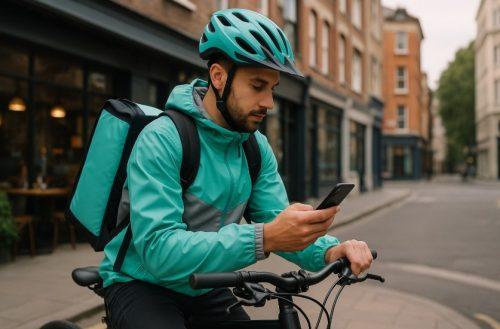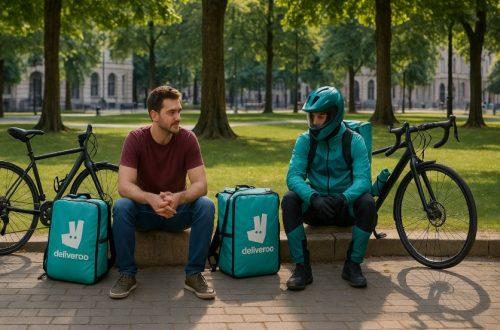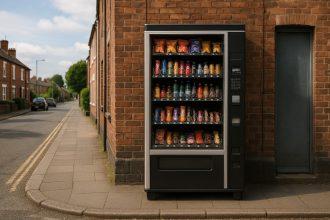|
Getting your Trinity Audio player ready...
|
Are you thinking about becoming a Deliveroo driver and wondering how much you could actually earn? In the ever-growing gig economy, flexibility is a major perk, but understanding the real financial rewards is equally essential. With Deliveroo, there’s no fixed hourly wage, which often leads to confusion about potential earnings.
Drivers are paid per delivery, and while the app gives you some control over your schedule, your income can vary widely based on your efficiency, location, and when you choose to work.
From the potential to earn over £3,000 a month to managing vehicle expenses and fuel costs, knowing the true earnings landscape is key. This blog breaks down everything you need to know, from pay structure to influencing factors, to give you a complete, realistic view of what it means to earn money with Deliveroo in the UK.
What Is the Pay Structure for Deliveroo Drivers?

Deliveroo operates on a per-delivery pay model, meaning you earn money for each order you successfully complete rather than being paid a fixed hourly wage. This system is designed to reward efficiency and flexibility, allowing you to take control of your earnings.
When you receive an order through the app, the fee is displayed before you accept it. The delivery fee depends on several factors, including distance, estimated time, and current traffic conditions.
Here’s how the pay structure breaks down:
- Per-delivery payment: Each delivery pays a base fee, often starting around £2.90 and reaching up to £6 for longer or more complex orders.
- Variable distance fee: The longer the delivery, the more you’re likely to earn.
- Batch orders: Sometimes, you can pick up multiple orders from the same restaurant, which increases efficiency and earning potential.
- 100% tips: You keep all the tips given by customers, and they’re paid along with your delivery fees.
Payments are sent weekly on Tuesdays, and there’s also a cash-out option that lets you access your earnings instantly for a small fee (typically 50p). Since you are a self-employed contractor, there’s no guarantee of a minimum wage, but the structure allows those who plan their time well to make substantial income.
The bottom line? Your income depends heavily on how many deliveries you complete, when and where you work, and how efficiently you manage your time on the road.
How Much Can You Earn Per Hour as a Deliveroo Driver?
Since Deliveroo pays per order, your hourly earnings can vary. However, you can estimate a typical hourly rate based on how many deliveries you complete and the fees per delivery.
On average, most Deliveroo drivers in the UK report earnings ranging from £7.50 to £22.50 per hour, depending on demand, location, and time of day.
Here’s a breakdown of potential hourly income based on different working scenarios:
| Delivery Speed | Deliveries/Hour | Average Fee/Delivery | Hourly Earnings |
| Slow | 1–2 | £3.50 – £4.50 | £7.50 – £10 |
| Average | 2–3 | £4.00 – £5.00 | £12 – £15 |
| Fast/Batched | 3–4 | £5.00 – £6.00 | £18 – £22.50 |
While these figures are averages, some top drivers working in high-demand areas during peak hours have reported earning over £3,000 per month. However, keep in mind that these are gross figures and do not account for expenses like fuel, insurance, or tax.
Deliveroo doesn’t offer guaranteed hourly pay, but if you’re efficient and strategic, you can earn competitive hourly wages compared to traditional part-time roles.
What Influences How Much You Make on Deliveroo?

Your earnings as a Deliveroo driver can fluctuate based on multiple real-time factors. The flexibility of the job allows you to choose your hours and locations, but these choices significantly impact how much you take home. Here’s a closer look at the core elements that determine your income.
Time of Day (Peak vs Off-Peak)
When you work can be just as important as how much you work. Peak hours, such as weekday lunch times (11:30 am – 2 pm) and evening dinner times (6 pm – 9 pm), typically offer more frequent orders and higher per-delivery fees.
Weekends, particularly Friday and Saturday nights, are known for surges in demand. Conversely, working during off-peak hours often leads to long wait times between orders, lowering your hourly earnings.
Location (Busy Urban Areas vs Quieter Zones)
Your chosen delivery zone also plays a crucial role. Urban areas like London, Birmingham, and Manchester have the best restaurant density and population, meaning more orders and shorter travel times between pickups and drop-offs. In contrast, quieter towns or rural areas might offer fewer delivery opportunities, resulting in lower hourly income.
Number of Orders Completed
The more deliveries you can complete in an hour, the higher your earnings. This is where strategic decision-making matters, being close to popular restaurants, accepting batched orders, and knowing local traffic patterns can boost the number of deliveries you finish per hour.
Delivery Distance and Batching Opportunities
Shorter distances between pick-up and drop-off points increase your chances of completing more orders per hour. Occasionally, you may receive back-to-back orders from the same restaurant going to nearby customers. These “batched” orders can drastically increase earnings in less time.
Earnings Influence
| Factor | Impact on Earnings |
| Peak hours | Higher delivery frequency and fees |
| City centre locations | More orders and less downtime |
| Batching opportunities | More money for less travel time |
| Shorter delivery distances | Quicker completion rate |
In short, your income is directly tied to how well you plan your time and routes, and how efficiently you work during high-demand periods in busy areas.
Do Deliveroo Drivers Keep All Their Tips?

Yes, one of the major perks of working with Deliveroo is that you keep 100% of the tips you receive from customers. These tips are processed automatically through the app and are paid to you alongside your weekly delivery earnings.
Here’s how tips work within the Deliveroo system:
- Full ownership: No commission or deduction is taken from customer tips.
- Payment method: Tips paid via the app appear in your weekly pay summary.
- Instant recognition: You can see tips added after each order, motivating better service.
Customers can tip either during the checkout process or after delivery. A prompt is shown in the app asking them if they want to tip you. Good customer service, polite interactions, and prompt deliveries often increase the likelihood of receiving a tip.
While tips can be unpredictable, they are a meaningful addition to your income, especially if you’re delivering during high-demand hours when customers are more appreciative of quick service. In some cases, tips have added an extra £20–£30 per day for drivers working busy shifts.
What Other Costs Should You Consider as a Deliveroo Driver?
Being self-employed with Deliveroo offers freedom, but also means you are responsible for your own expenses. These can eat into your gross income, so it’s important to factor them in when calculating your net earnings.
Here are the most common costs:
- Fuel: For car or scooter drivers, fuel can be a major weekly expense. A full tank may cost £50 or more, depending on vehicle type and usage.
- Vehicle wear and tear: Frequent driving leads to maintenance issues like tyre replacements, brake repairs, and oil changes.
- Insurance: You’ll need both regular vehicle insurance and food delivery insurance (commonly known as “hire and reward” insurance), which may cost between £700 and £1,000 annually.
- Phone data and accessories: Running the Deliveroo app requires a reliable smartphone with sufficient data. You might also invest in a phone mount or power bank.
- Tax and National Insurance: As a self-employed individual, you’ll need to declare income and pay tax annually. It’s advised to set aside a portion of your earnings for this.
Ignoring these expenses can give you a misleading idea of your income. Planning ahead ensures you understand your real take-home pay and can keep your business sustainable in the long term.
Is There a Difference Between Part-Time and Full-Time Earnings?

Yes, the number of hours you commit each week has a significant impact on your potential income. Whether you’re treating Deliveroo as a side gig or a full-time job, your weekly earnings will differ based on availability and demand.
Here’s a comparison of part-time vs full-time earnings based on average hourly rates:
| Work Type | Hours/Week | Average Hourly Rate | Weekly Earnings |
| Part-Time | 10–20 | £10 – £14 | £100 – £280 |
| Full-Time | 30–45 | £12 – £18 | £360 – £810 |
Part-time drivers often use Deliveroo to supplement another job or study schedule. They usually work evenings and weekends during peak hours. On the other hand, full-time drivers optimise their schedules by working high-demand slots across the week and accepting more orders per hour.
Your flexibility, location, and efficiency will determine how close you get to the higher end of these ranges. Deliveroo doesn’t set a cap on how many hours you can work, so if demand allows, there’s potential to earn more.
When and How Do Deliveroo Drivers Get Paid?
Deliveroo makes payments simple and reliable. Drivers are paid every Tuesday for all deliveries completed the previous week, directly into their linked bank account.
Here’s how the payment system works:
- Weekly payouts: Earnings from Monday to Sunday are sent the following Tuesday.
- Instant cash out: If you need your money sooner, you can use the in-app cash-out feature, which sends the money immediately for a small 50p fee.
- Tip inclusion: Tips received via the app are paid alongside your delivery fees.
- Earnings summary: The app provides a clear breakdown of your weekly earnings, including delivery fees, distance fees, tips, and cash-outs.
This system is especially helpful if you’re budgeting weekly or relying on a steady cash flow. You don’t have to invoice anyone or chase payments, the app automates everything. It’s efficient, transparent, and tailored to a freelance lifestyle.
What Are the Requirements to Become a Deliveroo Driver?

Joining Deliveroo is relatively straightforward, but you must meet certain criteria and provide appropriate documentation to begin delivering.
Here’s what you’ll need:
- Age: You must be 18 or older.
- Right to work in the UK: Valid documents like a UK passport, EEA ID card, biometric residence permit, or visa.
- Proof of address: A bank statement or utility bill.
- Smartphone: A device with iOS 13.6 or Android 6.0 and above, plus NFC and both front and rear cameras.
- Vehicle: A bicycle, scooter, or car with safety gear such as an insulated bag. Motorised vehicles must also have food delivery insurance.
- Driving documents: If using a motor vehicle, a UK driving licence or CBT (for scooters) is required.
Once accepted, you’ll be invited to order your rider kit, which includes essentials like a thermal bag, optional phone mount, and jacket. The onboarding process is digital and can be completed within a few days if all documents are submitted correctly.
Is Being a Deliveroo Driver Worth It in the UK?
Whether being a Deliveroo driver is worth it depends on your personal goals, location, and availability. For many, it offers a perfect balance of flexibility and earnings. The job suits students, part-timers, or full-time freelancers seeking autonomy.
Here’s a breakdown of pros and cons:
| Pros | Cons |
|---|---|
| Flexible schedule | No guaranteed minimum income |
| No boss or fixed hours | Responsibility for all work expenses |
| Keep 100% of customer tips | Weather-dependent, especially for cyclists |
| Weekly payouts with instant cash-out option | Income varies based on location |
If you’re disciplined, know your area well, and can plan your shifts during peak hours, you can absolutely make a decent income. It’s especially appealing to those who value control over their working life.
Conclusion
Deliveroo offers a modern way to earn income on your terms. With no set shifts and unlimited earning potential, it’s an appealing choice for people looking for flexibility. While the earnings per hour vary depending on time, location, and effort, many riders find the job rewarding both financially and in terms of lifestyle.
Understanding the real costs and earnings potential is vital before jumping in. From tips and bonuses to vehicle expenses and taxes, being informed can make all the difference. If you’re motivated, strategic, and service-oriented, Deliveroo can be a great opportunity to earn well while staying in control of your work-life balance.
FAQs
How much can you realistically earn as a Deliveroo driver per week?
You can realistically earn between £100 and £800 per week depending on your location, hours, and efficiency.
Do Deliveroo drivers get paid more during peak hours?
Yes, working during lunch and dinner peaks typically results in higher earnings per hour.
Can you work Deliveroo as a side hustle only on weekends?
Absolutely, many drivers work Deliveroo part-time on weekends to supplement other income.
What’s the best way to increase income on Deliveroo?
Deliver during peak hours in busy areas and accept batched orders whenever possible.
Are there penalties for rejecting orders on Deliveroo?
No, you are free to reject any order without penalty as an independent contractor.
What’s the minimum and maximum delivery pay per order?
The pay per delivery ranges from about £2.90 to £6, depending on the distance and complexity.
Do Deliveroo drivers need to report earnings for tax purposes?
Yes, as a self-employed worker, you must declare all income to HMRC and handle your own tax.








